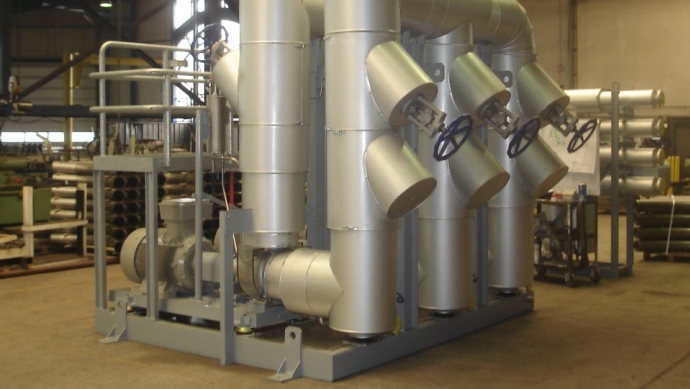Piping in thermal oil plants are exposed to stress factors of many kind: Their own weight (including heat insulation) and the weight of the heat transfer fluid that is passing through them lead to loads and deformations. Moreover, due to the temperature increase of the fluid (from room temperature to process temperatures up to 400 °C), the process heat is transferred to the piping system by convective heat transfer and thermal conduction. As a consequence, the pipes expand and this expansion affects the connection nozzles of the plant components such as pumps or vessels for which regularly limited nozzle loads are permitted.
In view of the mechanical stability and the service life of the plant is is to ensure that the permitted nozzle loads are not exceeded. But how can these requirements be realized in practice under cost-related considerations and short project periods?
heat 11 has developed a procedure that captures the cutting loads of the piping system on the nozzle of the plant components at different load cases and determines appropriate solutions to discharge these loads. For this, the cutting loads in the system are calculated analytically and compared with the manufacturer-specific requirements of the corresponding aggregates (such as pumps). By means of intuitive and discursive methods, solutions will then be compiled which at last are verified analytically and – if suitable – are assigned in the further construction and procurement process.
The figure shows the thermal load of a three-fold pump unit of a completed project in the chemicals industry. The red fields show the most heavily stressed fields of the assembly. The data acquired from the computer-aided simulation serve the development of a static optimum support of the piping system on the pump nozzles. “With this method we have succeeded in taking a big step in view of the improvement of the durability and service life of thermal oil plants.” said Dr. Dietmar Hunold, general manager technology and new markets at heat 11.
The method was developed in cooperation with the chair of mechanical engineering at Bielefeld College of Applied Sciences. The integration of the college not only ensured that methodology and calculations correspond to scientific standards but also a smooth transfer of the research results in the practice could be ensured.
The study was carried out by Phillip Riechmann, project engineer at heat 11, who is also responsible for the transition of the research results into the project work.





Comments are closed.